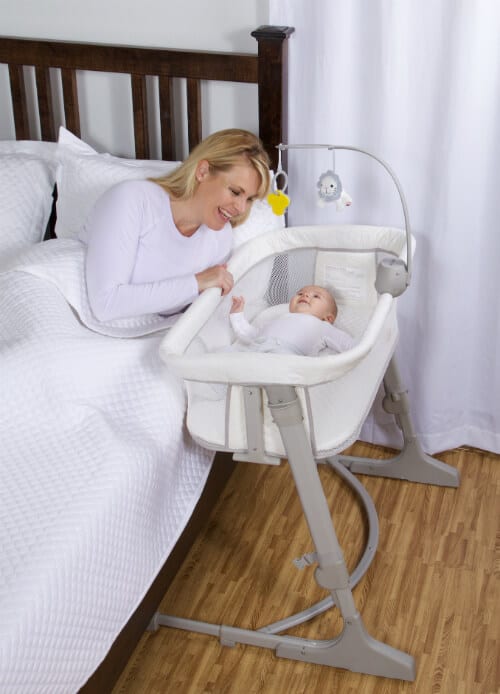Co-Sleeping Safely
I read about a study that claimed co-sleeping was dangerous. Is that true?
The Facts About Co-sleeping
On September 29, 1999 a major news report entitled “Hazards Associated with Children Placed in Adult Beds” was carried in nearly every major newspaper and many national television programs, putting fear into parents. The day before this study broke I was interviewed by The New York Times, The Washington Post and several other major newspapers. CNN even sent a camera crew to our home for comments on this new research. Do parents who sleep with their infants need to worry? No! Here’s the scoop. This study appeared in the October issue of The Archives of Pediatrics and Adolescent Medicine. Researchers at the U.S. Consumer Products Safety Commission reviewed death certificates from 1990 through 1997 and found 515 deaths of children under two years who were placed to sleep on adult beds. Of these deaths, 121 were reported to be due to overlying of the child by the parent, other adult, or sibling sleeping in the bed with the child. 394 deaths were due to entrapment in the bed structure, such as wedging of the child between the mattress and side rail or wall, suffocation in waterbeds, or head entrapment in bed railings. Most of these deaths occurred in infants under the age of three months. Like so much research, this was a good news/bad news scenario. The importance of this research is that it calls attention to parents who choose to sleep with their babies—and many do—to please do it safely. The problem with this study is that it caused unnecessary fear in the millions of parents who safely and responsively sleep with their babies. While the Consumer Products Safety Commission (CPSC) made a valid point that parents should be aware of the potential dangers of unsafe sleeping practices, they went too far in issuing a blanket statement that parents should not sleep with their babies under two years of age.
Why its Possible to Co-Sleeping Safely
When science and common sense don’t match, suspect faulty science. Co- sleeping itself is not inherently dangerous. The CPSC sleep study estimated that 64 deaths per year occurred in infants sleeping with their parents. The fact is that many more infants die when sleeping alone in a crib than when sleeping in their parents’ bed. While the authors of this study indicated that their conclusions were not statistically valid, it would have been helpful if the authors made the point that the great majority of SIDS (remember it used to be called “crib death”) occurs in infants sleeping alone in cribs. Instead of making parents afraid to sleep with their babies, a more contemporary approach would be to teach parents who choose to co-sleep to do it safely. Here are the precautions for safe co-sleeping:
- Always put babies under six months to sleep on their backs and not their tummies.
- Don’t sleep with your baby if you are under the influence of drugs or alcohol or any substance that could diminish the awareness of your baby.
- Don’t sleep with baby on soft surfaces, such as bean bags, water beds, and couches.
- Avoid crevices between mattress and wall or mattress and side rail.
- Avoid side rails, head boards, and foot boards that have slats that could entrap baby’s head.

- Avoid putting your bed nearby curtains or blinds that have dangling strings that could strangle baby.
- Only one baby in bed at a time, please.
Co-sleeper
For parents who intuitively don’t like the separation anxiety of their infant sleeping alone in a crib, but do not want to, or are fearful of, sleeping in the same bed with their baby, here is a compromise. Try the Arm’s Reach® Co- sleeper® bassinet, a crib-like infant bed that attaches securely and safely right next to the parent’s bed. With this nighttime nurturing device, parents have their own sleeping space, baby has his or her own sleeping space, and baby and parents are in close touching and nursing distance to one another. (For more information about co-sleepers, see www.armsreach.com and check out the video below.)
Night Nursing
Despite the media hype on the dangers of co-sleeping, the facts are that much of the world's population sleep with their babies and do so safely. How could a sleeping arrangement that has been practiced for centuries all of the sudden be "unsafe?" We believe that co-sleeping is the nighttime parenting style of the millennium for two reasons: more and more mothers are breastfeeding and sleeping next to your baby makes breastfeeding easier. When baby is hungry, mother can simply feed her baby without either member of the nursing pair fully awakening. Martha has dubbed night nursing as the "lazy mom's option." She has slept with and night nursed most of our babies and still felt rested the next day. In this way, both baby's need for nighttime feeding and nurturing and mother's need for sleep can be met. The second reason why co-sleeping is contemporary is that more and more dual income parents are now separated from their infants during the day. Co-sleeping allows working parents to reconnect with their babies at night and to make up for missed touch time during the day.
Nighttime For Little People
Nighttime is a scary time for little people. When considering where baby should sleep, look at things from a baby's point of view. If you were an infant, would you rather sleep alone in a dark room behind bars or right next to your favorite person in the whole wide world and inches away from your favorite cuisine? The choice is obvious. There is no right or wrong place for baby to sleep. Each family needs to work out the sleeping arrangement that gets all family members the best night's sleep. Whatever nighttime arrangement you choose, do it wisely and safely. Sleep well!
